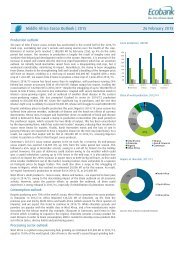www.ebook777.com
Make_Getting_Started_with_Processing_Second_Edition
Make_Getting_Started_with_Processing_Second_Edition
You also want an ePaper? Increase the reach of your titles
YUMPU automatically turns print PDFs into web optimized ePapers that Google loves.
170 Getting Started with Processing<br />
<strong>www</strong>.<strong>ebook777.com</strong><br />
}<br />
noFill();<br />
stroke(204, 51, 0);<br />
beginShape();<br />
for (int i = 0; i < homeRuns.length; i++) {<br />
float x = map(i, 0, homeRuns.length-1, 20, 460);<br />
float y = map(homeRuns[i], 0, 60, 100, 20);<br />
vertex(x, y);<br />
}<br />
endShape();<br />
This example is so minimal that it’s not necessary to store this<br />
data in arrays, but the idea can be applied to more complex<br />
examples you might want to make in the future. In addition, you<br />
can see how this example could be enhanced with more information—for<br />
instance, information on the vertical axis to state<br />
the number of home runs and on the horizontal to define the<br />
year.<br />
Example 12-3: 29,740 Cities<br />
To get a better idea about the potential of working with data<br />
tables, the next example uses a larger data set and introduces a<br />
convenient feature. This table data is different because the first<br />
row, the first line in the file, is a header. The header defines a<br />
label for each column to clarify the context. This is the first five<br />
lines of our new data file called cities.csv:<br />
zip,state,city,lat,lng<br />
35004,AL,Acmar,33.584132,-86.51557<br />
35005,AL,Adamsville,33.588437,-86.959727<br />
35006,AL,Adger,33.434277,-87.167455<br />
35007,AL,Keystone,33.236868,-86.812861<br />
The header makes it easier to read the code—for example, the<br />
second line of the file states the zip code of Acmar, Alabama, is<br />
35004 and defines the latitude of the city as 33.584132 and the<br />
longitude as -86.51557. In total, the file is 29,741 lines long and it<br />
defines the location and zip codes of 29,740 cities in the United<br />
States.<br />
The next example loads this data within setup() and then draws<br />
it to the screen in a for loop within draw(). The setXY() function<br />
converts the latitude and longitude data from the file into a<br />
point on the screen:



